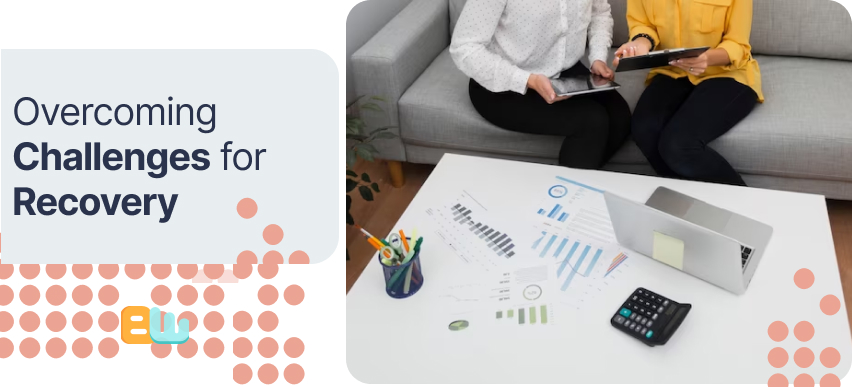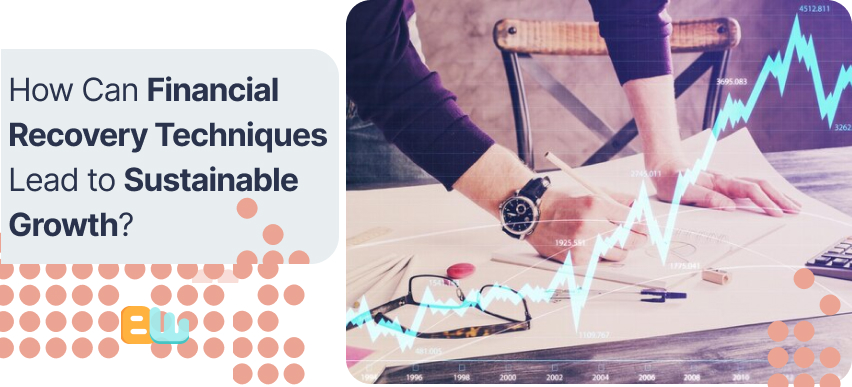
Financial recovery is essential to sustainable growth in today’s fast-paced and ever-changing economic landscape. Businesses and communities across the globe are constantly facing economic challenges, such as market failures, vulnerability, and resilience. To overcome these challenges and achieve long-term prosperity, it is crucial to implement effective financial recovery techniques. By understanding the concept of economic recovery, exploring strategies for revenue generation and cost reduction, encouraging innovation, overcoming challenges, and embracing collaborative efforts, organizations can pave the pathway for sustainable growth and economic development.
Understanding Financial Recovery Techniques

Financial recovery involves a series of strategic measures to restore financial health, ensure economic growth, and promote sustainable development. It focuses on addressing economic vulnerabilities, developing resilience, and implementing best practices in the financial sector. Organizations can enhance liquidity, strengthen their economic engine, and foster short-term and long-term sustainable growth by adopting financial recovery techniques. These techniques are vital in navigating economic uncertainties, ensuring financing availability, and promoting resource redistribution for sustainable development.
The Concept of Financial Recovery
Financial recovery encompasses a broader concept of economic growth and resilience. It emphasizes the importance of reclaiming financial stability and implementing strategies to recover from financial setbacks. The concept recognizes that resilience and vulnerability are inherent aspects of economic activity. Therefore, financial recovery techniques aim to address vulnerabilities, build resilience, and lay the foundation for sustainable growth. By developing comprehensive strategies, countries, businesses, and communities can effectively overcome economic challenges, adapt to changing digital marketing conditions, and foster sustainable development in the face of global uncertainties.
Techniques for Financial Recovery
Implementing effective techniques for financial recovery is crucial in rebuilding financial strength and ensuring sustainable growth. These techniques encompass a range of best practices, including strategic financial planning, developing recovery roadmaps, enhancing liquidity, and optimizing financial resources. Organizations can navigate market uncertainties, improve financial resilience, and foster sustainable development by adopting these techniques. The financial sector is crucial in promoting financial recovery, as it provides the necessary expertise, knowledge, and tools to support sustainable growth. Therefore, leveraging the expertise of financial institutions and implementing best practices can drive economic recovery and pave the way for sustainable prosperity.
Revenue Generation and Cost Reduction

Achieving sustainable growth requires balancing generating revenue and reducing costs. By effectively managing revenue streams, businesses and communities can create financial stability and support the attainment of sustainable development goals. Simultaneously, implementing cost-reduction strategies ensures the efficient allocation of resources and enhances financial resilience. Through revenue generation and cost reduction, organizations can create a sustainable financial foundation, efficiently allocate resources, and foster long-term prosperity.
Implementing effective budgeting and financial planning methods
One of the fundamental techniques for achieving financial recovery is the implementation of effective budgeting and financial planning methods. These methods involve meticulously analyzing expenditures, setting financial goals, and developing sustainable financial strategies. By carefully managing expenses, organizations can optimize financial resources and ensure the efficient allocation of funds to priority areas. Effective budgeting and financial planning methods also enable organizations to monitor financial performance, identify areas for improvement, and make informed decisions.
Identifying and addressing areas of excessive spending
Identifying and addressing areas of excessive spending is vital for financial recovery and sustainable growth. By scrutinizing expenditures, organizations can eliminate unnecessary costs, optimize financial resources, and enhance sustainability. Organizations can achieve sustainable financial growth, improve efficiency, and strengthen their economic resilience by identifying and addressing areas of excessive spending.
Finding alternative sources of revenue
Finding alternative sources of revenue is essential for financial recovery and sustainable growth. Relying solely on traditional revenue streams may limit an organization’s potential for resilience and expansion. Organizations can mitigate the risks of volatile market conditions by diversifying revenue streams and exploring new economic engines. By finding alternative sources of revenue, organizations can reduce their dependence on a single market or sector, enhance financial resilience, and foster sustainable growth.
Negotiating better deals with suppliers and vendors
Negotiating better deals with suppliers and vendors effectively reduces costs, improves financial resilience, and supports financial recovery efforts. Organizations can achieve cost reduction and optimize supplier relationships by leveraging negotiation strategies. By negotiating better deals, organizations can achieve significant cost reductions, resilience, and financial recovery, ultimately paving the way for sustainable growth.
Encouraging Innovation for Sustainable Growth

Innovation is at the core of sustainable growth and economic recovery. By fostering a culture of innovation within organizations, we can address global challenges, such as climate change, and drive sustainable economic development. Embracing innovation enables businesses and communities to adapt to changing market conditions, develop innovative solutions, and create a sustainable future. We can achieve economic recovery, resilience, and sustainable growth through continuous innovation while addressing pressing global issues.
Creating a culture of innovation within the company
Creating a culture of innovation within the company is paramount for sustainable growth. It involves cultivating an environment that encourages creativity, experimentation, and collaboration. Organizations can harness their workforce’s collective intelligence and creativity by creating a culture of innovation, driving sustainable growth and economic recovery.
Encouraging and implementing employee ideas and suggestions
Encouraging and implementing employee ideas and suggestions is a powerful strategy for fostering innovation and driving sustainable growth. Organizations can tap into their diverse skills, knowledge, and perspectives by actively engaging employees in innovation. By valuing and implementing employee ideas, organizations can unlock the full potential of their human capital, drive innovation, and achieve sustainable growth.
Investing in research and development
Investing in research and development (R&D) is crucial for sustainable growth and economic recovery. R&D expenditure fuels innovation, drives product and process improvements, and supports sustainable development goals. By investing in R&D, organizations can address market failures, promote economic resilience, and foster sustainable growth. Organizations prioritizing research and development can position themselves as leaders in sustainable growth and economic recovery, contributing to long-term prosperity.
Overcoming Challenges for Recovery

Overcoming challenges is integral to financial recovery and sustainable growth. The journey towards recovery often involves managing roadblocks, such as economic uncertainties, vulnerability, and resilience. By identifying potential roadblocks, managing debt, creating budgets, and seeking professional financial advice, organizations can enhance their financial resilience, overcome challenges, and ensure a successful recovery. Overcoming challenges requires strategic planning, adaptability, and resilience, enabling organizations to navigate economic uncertainties and foster sustainable growth.
Identifying Potential Roadblocks
Identifying potential roadblocks is crucial for financial recovery and sustainable growth. These roadblocks can impede economic activity, hinder growth, and lead to vulnerability. Organizations can chart a pathway toward recovery and resilience by understanding and mitigating these roadblocks. Organizations can proactively navigate challenges, foster resilience, and ensure sustainable growth by identifying and addressing potential roadblocks.
Managing debt and reducing expenses
Managing debt and reducing expenses are critical strategies for financial recovery and sustainable growth. Organizations can reduce financial liabilities, minimize interest rates, and improve financial resilience by effectively managing debt. Likewise, by actively and strategically reducing expenses, organizations can optimize resource allocation, enhance financial stability, and create room for growth.
Creating a budget and sticking to it
Creating a budget and sticking to it is instrumental in financial recovery and sustainable growth. A well-defined budget provides a roadmap for financial planning, resource allocation, and expenditure control. Organizations can effectively manage resources, optimize expenditures, and foster sustainable growth by creating a budget and adhering to it.
Seeking professional financial advice and guidance
Seeking professional financial advice and guidance is vital for financial recovery and sustainable growth. The expertise and insights offered by financial advisors, consultants, and professionals can help organizations navigate complex financial challenges, identify growth opportunities, and develop effective recovery strategies. Organizations can leverage expert knowledge, strengthen financial resilience, and pave the way for sustainable growth by seeking professional financial advice.
Collaborative Efforts for Stronger Economies

Collaboration drives economic recovery, sustainable growth, and resilience. Organizations can collectively address global challenges, leverage shared resources, and promote sustainable development by joining forces with international, regional, and local stakeholders. Collaboration allows for exchanging best practices, knowledge, and expertise, fostering innovative solutions to complex economic issues. By actively participating in collaborative efforts, organizations can contribute to the global agenda, empower local communities, and achieve lasting economic recovery and sustainable growth.
Importance of Collaboration in Recovery
Collaboration is pivotal in economic recovery by fostering partnerships, driving joint efforts, and synergizing resources. The importance of collaboration in recovery stems from the realization that global challenges, such as climate change and economic uncertainties, require collective action and shared responsibility. Collaboration enables organizations to pool their expertise, financial resources, and networks, leading to more effective and sustainable recovery strategies. Organizations can amplify their impact, foster resilience, and achieve sustainable growth by partnering with governments, NGOs, and other stakeholders.
Success Stories of Effective Collaborations
Success stories of effective collaborations highlight the transformative power of joint efforts and shared goals. Worldwide, case studies and success stories demonstrate how collaborations between governments, businesses, communities, and international organizations have successfully driven economic recovery, fostered sustainable growth, and empowered local communities. The World Bank Group, for instance, has been instrumental in supporting collaborative efforts in developing countries, providing financial resources, technical expertise, and policy advice to promote sustainable development.
How Can Financial Recovery Techniques Lead to Sustainable Growth?

Financial recovery techniques are crucial in paving the pathway for sustainable growth, resilience, and prosperity. Organizations can restore financial health, address economic vulnerabilities, and foster sustainable development by implementing these techniques. Financial recovery catalyzes sustainable growth, enabling businesses and communities to achieve long-term goals, support sustainable development, and ensure economic prosperity. Organizations can achieve sustainable growth, drive economic recovery, and contribute to a prosperous future by implementing financial recovery techniques.
Conclusion
Implementing effective financial recovery techniques is crucial for sustainable growth. Businesses can strengthen their financial position by focusing on revenue generation and cost reduction. This includes implementing budgeting and financial planning methods, identifying areas of excessive spending, finding alternative sources of revenue, and negotiating better deals with suppliers and vendors. Encouraging innovation is also vital to long-term success. Businesses can stay ahead of the competition by creating a culture of innovation, implementing employee ideas, and investing in research and development. Overcoming challenges such as managing debt, creating a budget, and seeking professional advice is essential. Lastly, collaborating with other businesses can lead to stronger economies and mutual success. By implementing these financial recovery techniques, businesses can achieve sustainable growth and financial stability.
